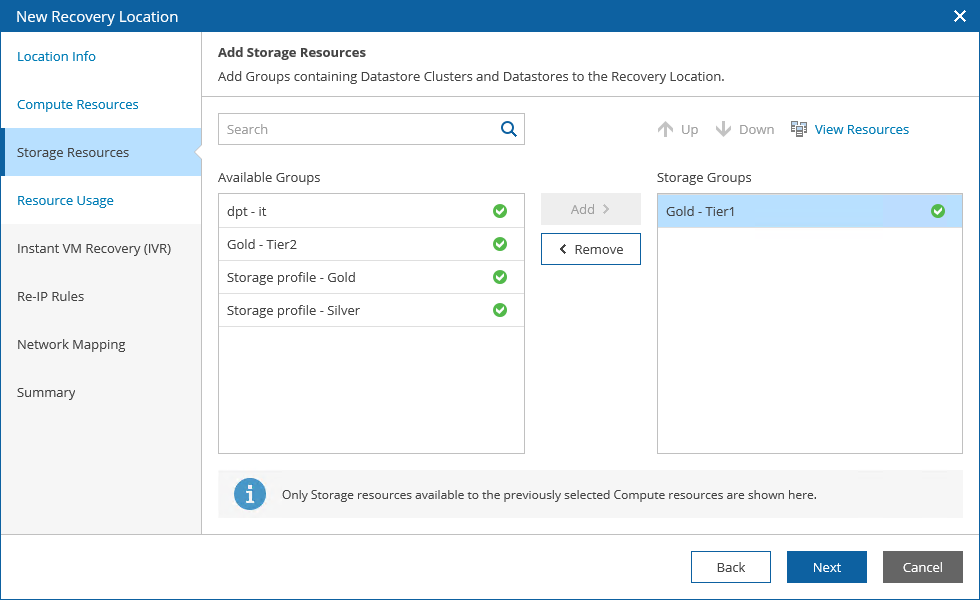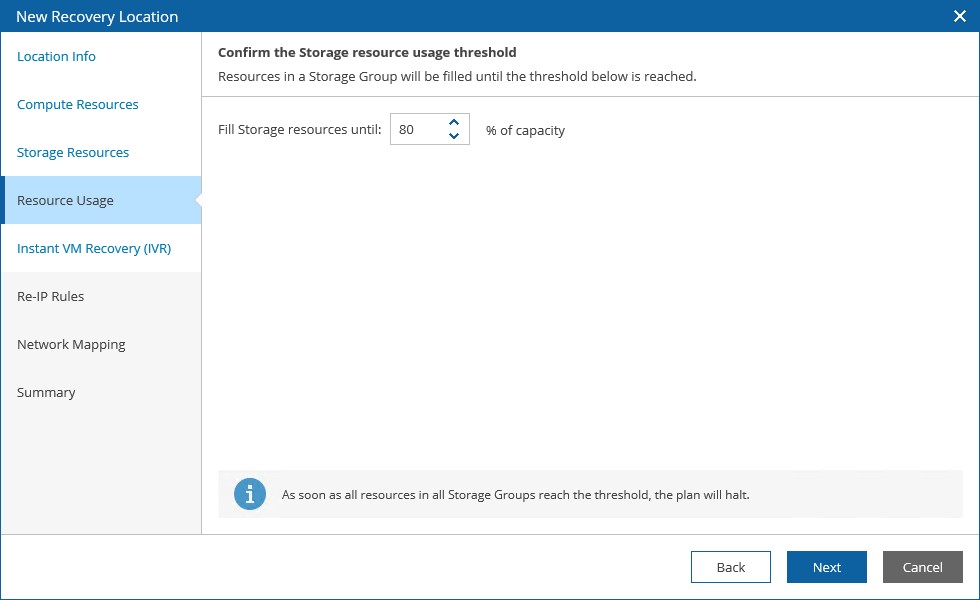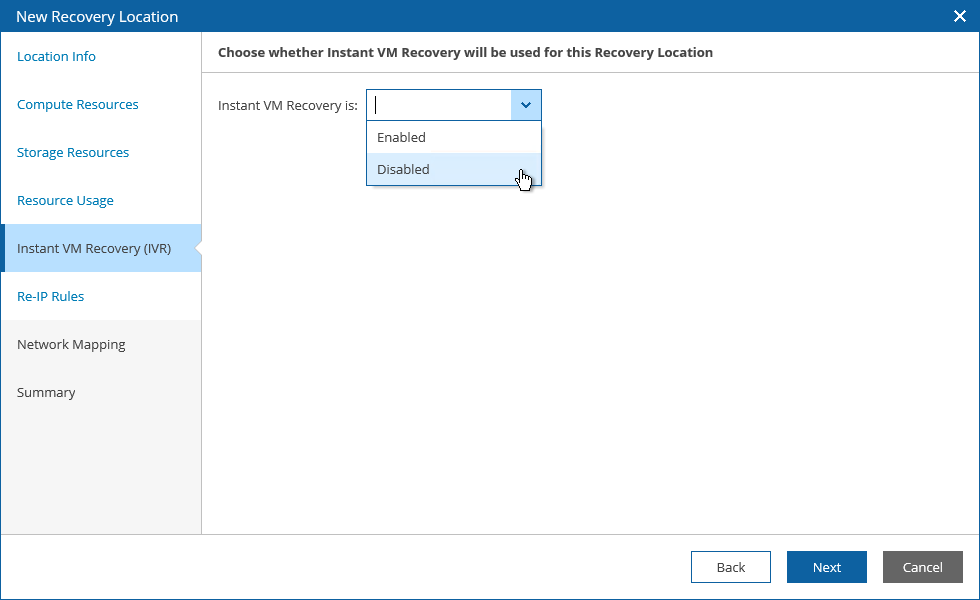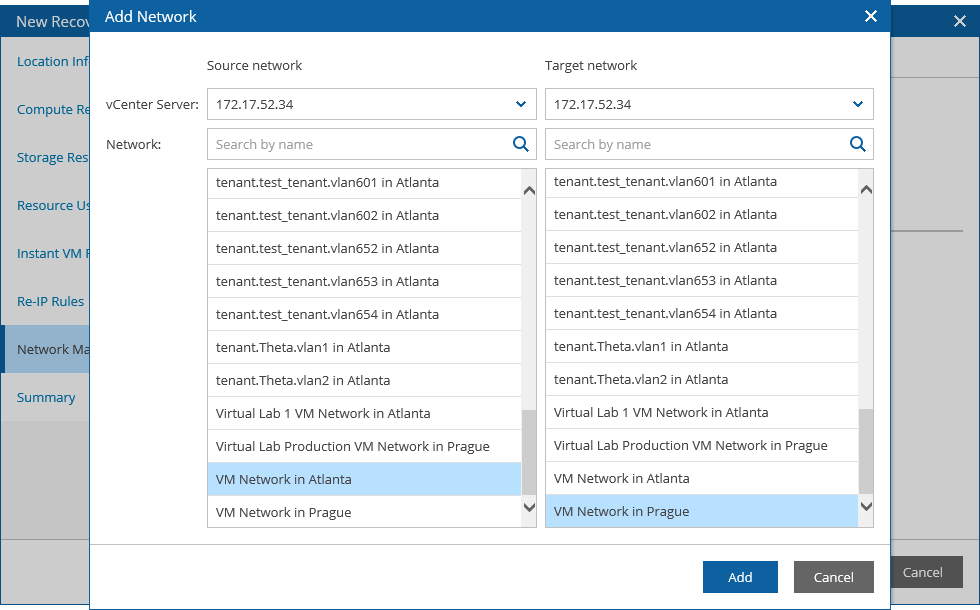 This is an archive version of the document. To get the most up-to-date information, see the current version.
This is an archive version of the document. To get the most up-to-date information, see the current version.Adding Recovery Locations
All resource groups created based on vCenter Server tags will automatically become available for creation of recovery locations in the VAO UI. However, after you create a tag category, edit a tag category or assign a tag to an object in the vSphere inventory, the changes may not appear in the VAO UI immediately. Data synchronization process between VAO and Veeam ONE may take up to 3 hours to complete.
To add a recovery location:
- Log in to the VAO UI as a VAO Administrator. For details, see Accessing VAO UI.
- Switch to the Administration tab.
- Navigate to Recovery Locations.
- Click Add.
- Complete the New Recovery Location wizard.
- At the Location Info step, use the Name and Description fields to enter a name for the new location and provide a description for future reference. The maximum length of the location name is 64 characters; the following characters are not supported: * : / \ ? " < > |
- At the Compute Resources step, specify target hosts and clusters where restored VMs must be registered. To do that, select the required resource groups in the list of available groups and click Add.
To view hosts and clusters included into a resource group, select the group and click View Resources.
- At the Storage Resources step, specify destination datastores and datastore clusters where VM files must be stored. To do that, select the required resource groups in the list of available groups and click Add.
To view datastores and datastore clusters included into a resource group, select the group and click View Resources.
- At the Resource Usage step, specify the datastore capacity level that must not be breached during the recovery process for orchestration plans to complete successfully.
- At the Instant VM Recovery (IVR) step, choose whether you want to enable Instant VM Recovery for the location.
With Instant VM Recovery, all processed VMs will be immediately restored in the location by running directly from the backup files. Instant VM Recovery helps improve recovery time objectives (RTO), minimize disruption and downtime of the VMs.
For more information on the Instant VM Recovery feature, see the Veeam Backup & Replication User Guide, section Instant VM Recovery.
- At the Re-IP Rules step, select the Enable reconfiguration of IP addresses check box if you want to enable the functionality of automatic IP address transformation.
In case the IP addressing scheme in the source location differs from the target location scheme, you can create a number of re‑IP rules, and VAO will automatically reconfigure VM IP addresses.
When you restore from a VM backup or fail back to a new location, VAO checks if any of the specified re-IP rules apply to the recovered VM. If a rule applies, VAO changes the IP address configuration of the recovered VM using the Microsoft Windows registry.
To configure a re-IP rule:
- Click Add.
- In the Source VM section of the Add Re-IP Rule window, describe an IP numbering scheme adopted in the source location.
- In the Target VM section, describe an IP numbering scheme adopted in the target location. Specify an IP address, subnet mask and default gateway that will be used for recovered VMs.
- If necessary, define the DNS and WINS server addresses.
- In the Description field, specify a brief outline of the rule or any related comments.
- Click Add.
|
You can use the asterisk character (*) to specify a range of IP addresses. |
- By default, a recovered VM is connected to the same networks as the source VM. If the network configuration in the recovery location does not match the production network configuration, you can create a network mapping table for the location, so the recovered VM will be connected to the correct network.
To configure network mapping, at the Network Mapping step, select the Enable network mapping check box and click Add. The Add Network window will open.
- In the Source Network section, from the vCenter Server list, select a vCenter Server that manages source VMs. From the list of available networks, select a network to which the source VMs are connected.
For a vCenter Server to be displayed in the vCenter Server list, it must be connected to VAO as described in section Connecting VMware vSphere Servers.
- In the Target Network section, from the vCenter Server list, select a vCenter Server that will manage recovered VMs. From the list of available networks, select a network to which the recovered VMs must be connected.
- At the Summary step, review configuration information and click Finish.








